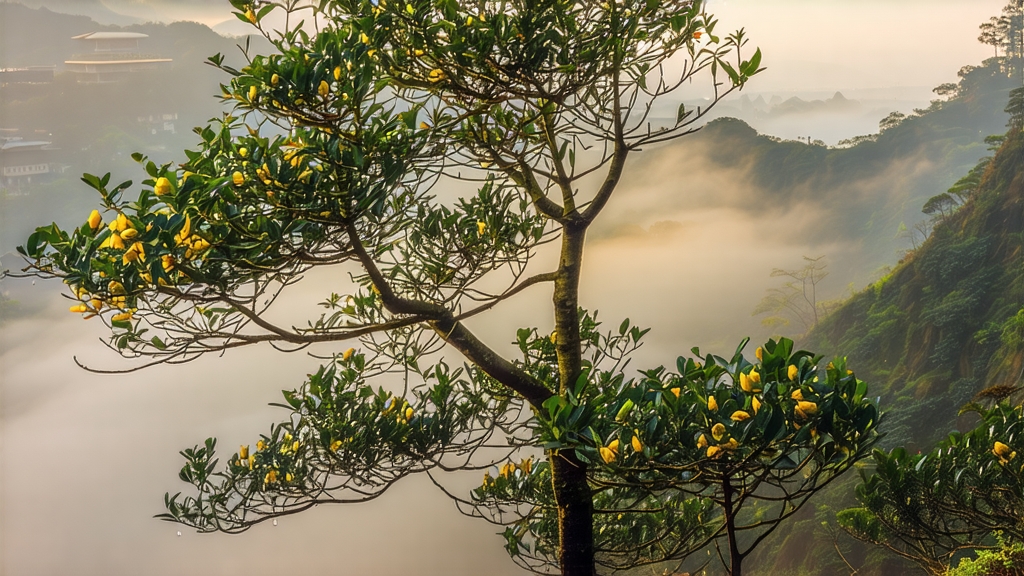
If green tea is the fresh-faced scholar of Chinese tea and pu-erh the bearded sage, then yellow tea is the quiet poet who stepped off the stage centuries ago, leaving behind only the faintest scent of warmed rice and mountain orchids. Among the handful of yellow teas that still survive, none carries more imperial gravitas than Mengding Huangya, the “Yellow Bud from the Summit of Meng.” Grown on the mist-capped peaks of Ya’an, Sichuan, this tea was once wrapped in yellow silk and borne by fast horses to the Tang-dynasty court, a journey of eleven hundred kilometres that began at dawn and ended by starlight. Today the horses are gone, the silk is frayed, yet the buds still arrive each spring, as slender and stubborn as ever, determined to prove that delicacy can outlast dynasties.
Historical whispers
Legends place the first plucking in 53 BCE, when the Daoist Wu Lizhen planted seven tea bushes on Mengding Mountain and declared them “celestial herbs.” By the Tang dynasty (618-907) the tea had become gongcha—tribute tea—reserved for the emperor’s own cup. Song-era chroniclers record that the buds were picked by “lip-ringed virgins” who bit the shoot rather than snap it, lest fingernail bruise the leaf. Qing bureaucrats formalised the ritual: 360 leaves exactly, one for each day of the lunar year, wrapped in lotus leaves, sealed with wax, and locked into bamboo tubes lined with ramie cloth. Only when the imperial courier arrived were the tubes opened, releasing a fragrance so soft it was said to “float three li against the wind.”
What makes it “yellow”?
Western drinkers often assume yellow tea is simply green tea with a fancy name. The difference lies in a nerve-racking extra step called men huang—“sealed yellowing.” After the kill-green wok roast, the leaf is piled in tiny heaps, no thicker than two fingers, wrapped in damp cotton, and left to breathe in its own warmth for four to eight hours. Enzymes gently oxidise the leaf edges while the core stays green, lending a straw-gold liquor and a flavour that hovers between fresh corn silk and roasted chestnut. Done too long, the tea becomes dull; too short, it remains shrill. Only a handful of masters still possess the muscle memory to judge the moment by scent alone: when the aroma shifts from grassy to the smell of warm rice just lifted from the clay pot, the leaf is unwrapped and given a final charcoal bake over bamboo embers.
Micro-terroir on a cloud mountain
Mengding rises 1 456 m above the Sichuan basin; the saddle-shaped summit traps a perpetual cloud sea. Morning mist refracts light into soft blues and violets, slowing photosynthesis and coaxing the plant to stockpile amino acids—especially L-theanine, responsible for the tea’s brothy sweetness. The soil is a friable purple sandstone rich in selenium and fluorine, drained by underground streams that keep the root zone cool even in July. Temperatures can swing 15 °C between noon and midnight; the stress concentrates aromatic volatiles, while the high altitude keeps insect pressure low, allowing the garden to remain pesticide-free for over two decades.
Plucking code: one bud, one leaf, before Qingming
The harvest window is cruelly short—about ten days straddling the Qingming festival (4–6 April). At dawn, when the mountain thermometer hovers at 12 °C, twenty-five pickers climb stone steps slick with moss. Each carries a bamboo tube lined with banana leaf; the tube is strapped to the waist so both hands remain free. Only the standard “one bud, one leaf” is taken, the leaf still furled like a miniature flag, the bud no longer than 2.5 cm. A seasoned picker gathers barely 500 g of fresh leaf in four hours; it takes 4.5 kg of fresh material to yield 1 kg of finished tea. By 9 a.m. the sun pierces the mist and work stops—any later, the leaf temperature rises, making the subsequent yellowing unpredictable.
Craft in miniature: six hours to immortality
Back at the cottage, the leaf is spread on woven rattan trays for two hours of withering, losing 8 % moisture and the grassy bite. The kill-green is done in a wok heated to 140 °C, but the master uses only his fingertips, flicking the leaf for precisely